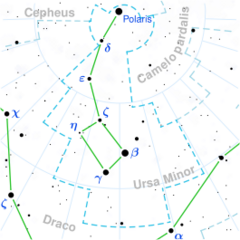Astronomy:Zeta Ursae Minoris
| Observation data Equinox J2000.0]] (ICRS) | |
|---|---|
| Constellation | Ursa Minor |
| Right ascension | 15h 44m 03.51892s[1] |
| Declination | +77° 47′ 40.1788″[1] |
| Apparent magnitude (V) | +4.29[2] |
| Characteristics | |
| Spectral type | A3Vn[3] |
| U−B color index | +0.05[4] |
| B−V color index | 0.038±0.005[2] |
| Variable type | Suspected δ Sct[5] |
| Astrometry | |
| Radial velocity (Rv) | −13.1±4.1[6] km/s |
| Proper motion (μ) | RA: 19.91[1] mas/yr Dec.: −1.99[1] mas/yr |
| Parallax (π) | 8.84 ± 0.12[1] mas |
| Distance | 369 ± 5 ly (113 ± 2 pc) |
| Absolute magnitude (MV) | −0.98[2] |
| Details | |
| Mass | ~3.4[7] M☉ |
| Radius | 6.15[8] R☉ |
| Luminosity | 227[2] L☉ |
| Temperature | 8,720[8] K |
| Rotational velocity (v sin i) | 210[9] km/s |
| Age | 180[10] Myr |
| Other designations | |
| Database references | |
| SIMBAD | data |
Zeta Ursae Minoris, which is Latinized from ζ Ursae Minoris, is a single[12] star in the northern circumpolar constellation of Ursa Minor, forming the northernmost part of the bowl in this "little dipper" asterism.[13] The star has a white hue and is faintly visible to the naked eye with an apparent visual magnitude of +4.28. It is located at a distance of approximately 369 light-years from the Sun based on parallax,[1] but is drifting further closer with a radial velocity of about –13 km/s.[6]

The stellar classification of Zeta UMi is A3Vn,[3] a notation that indicates this is an A-type main-sequence star with broad "nebulous" absorption lines in its spectrum due to rapid rotation. Based on photometric data, some light variability was suspected by R. A. Baker in 1926, and it may be a Delta Scuti variable.[5] It is a pulsating variable star, with a period of 15.8 hours, and it also undergoes eclipses.[14] The star is spinning with a projected rotational velocity of 210 km/s, which is creating an equatorial bulge that is estimated to be 10% larger than the polar radius.[9]
Zeta Ursae Minoris is about 180[10] million years old with 6.15[8] times the radius of the Sun. It is radiating 227[2] times the luminosity of the Sun from its photosphere at an effective temperature of 8,720 K.[8] This anomalously high temperature and an absolute magnitude of –0.98[2] may indicate it is on the verge of evolving into a giant star.[7] An infrared excess has been detected from an orbiting circumstellar disk.[10] A black body fit to the data yields a mean dust temperature of 160 K and an orbital radius of 42.5 AU.[8]
In some Arabic star charts it is listed as أخفى الفرقدين ʼakhfā al-farqadayn, meaning "the dimmer of the two calves", and paired with η Ursae Minoris as ʼanwar al-farqadayn, "the brighter of the two calves". The names may originally refer to a pair of Ibexes, and are more properly applied to γ UMi and β UMi, respectively, the brighter two stars in the rectangle of Ursa Minor.[15]
References
- ↑ 1.0 1.1 1.2 1.3 1.4 1.5 van Leeuwen, F. (2007). "Validation of the new Hipparcos reduction". Astronomy and Astrophysics 474 (2): 653–664. doi:10.1051/0004-6361:20078357. Bibcode: 2007A&A...474..653V.
- ↑ 2.0 2.1 2.2 2.3 2.4 2.5 Anderson, E.; Francis, Ch. (2012). "XHIP: An extended hipparcos compilation". Astronomy Letters 38 (5): 331. doi:10.1134/S1063773712050015. Bibcode: 2012AstL...38..331A.
- ↑ 3.0 3.1 Cowley, A. et al. (April 1969). "A study of the bright A stars. I. A catalogue of spectral classifications". Astronomical Journal 74: 375–406. doi:10.1086/110819. Bibcode: 1969AJ.....74..375C.
- ↑ Johnson, H. L. et al. (1966). "UBVRIJKL photometry of the bright stars". Communications of the Lunar and Planetary Laboratory 4 (99): 99. Bibcode: 1966CoLPL...4...99J.
- ↑ 5.0 5.1 Frolov, M. S. (April 1970). "List of Probable Delta Scuti Stars". Information Bulletin on Variable Stars 427: 1. Bibcode: 1970IBVS..427....1F.
- ↑ 6.0 6.1 Gontcharov, G. A. (November 2006). "Pulkovo Compilation of Radial Velocities for 35495 Hipparcos stars in a common system". Astronomy Letters 32 (11): 759–771. doi:10.1134/S1063773706110065. Bibcode: 2006AstL...32..759G.
- ↑ 7.0 7.1 Kaler, James B.. "Alifa al Farkadain". Stars. University of Illinois. http://stars.astro.illinois.edu/sow/alifa.html.
- ↑ 8.0 8.1 8.2 8.3 8.4 Cotten, Tara H.; Song, Inseok (July 2016). "A Comprehensive Census of Nearby Infrared Excess Stars". The Astrophysical Journal Supplement Series 225 (1): 24. doi:10.3847/0067-0049/225/1/15. 15. Bibcode: 2016ApJS..225...15C.
- ↑ 9.0 9.1 van Belle, Gerard T. (March 2012). "Interferometric observations of rapidly rotating stars". The Astronomy and Astrophysics Review 20 (1): 51. doi:10.1007/s00159-012-0051-2. Bibcode: 2012A&ARv..20...51V.
- ↑ 10.0 10.1 10.2 Su, K. Y. L. et al. (December 2006). "Debris Disk Evolution around A Stars". The Astrophysical Journal 653 (1): 675–689. doi:10.1086/508649. Bibcode: 2006ApJ...653..675S.
- ↑ "zet UMi". SIMBAD. Centre de données astronomiques de Strasbourg. http://simbad.u-strasbg.fr/simbad/sim-basic?Ident=zet+UMi.
- ↑ Eggleton, P. P.; Tokovinin, A. A. (September 2008). "A catalogue of multiplicity among bright stellar systems". Monthly Notices of the Royal Astronomical Society 389 (2): 869–879. doi:10.1111/j.1365-2966.2008.13596.x. Bibcode: 2008MNRAS.389..869E.
- ↑ Harrington, Philip S. (October 21, 2010). Cosmic Challenge: The Ultimate Observing List for Amateurs. Cambridge University Press. p. 38. ISBN 9781139493680. https://books.google.com/books?id=8mQmvT4wpWQC&pg=PA38.
- ↑ 14.0 14.1 "zet UMi". AAVSO. https://www.aavso.org/vsx/index.php?view=detail.top&oid=45887.
- ↑ Allen, Richard Hinckley (1899). Star-names and Their Meanings. G. E. Stechert. pp. 447–460. https://archive.org/details/bub_gb_5xQuAAAAIAAJ.
 |


